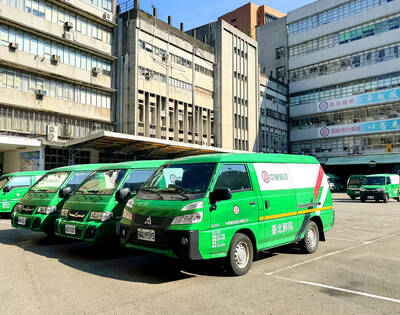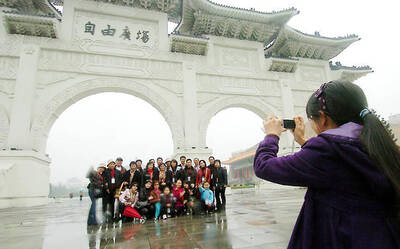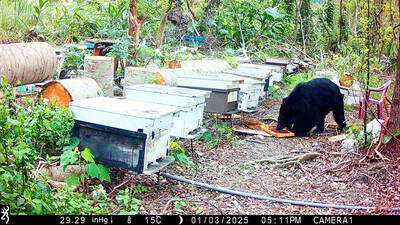The Ministry of Transportation and Communications (MOTC) and ride-hailing company Uber have failed to resolve their differences over a proposed amendment that would prohibit Uber from using its current operating model in Taiwan.
With the 60-day consultation period for the proposal having concluded on Friday last week, the ministry said that it would review public comments received, conduct a final review and draft measures to cover Uber drivers who might want to become taxi drivers before the rules take effect.
“Our directive remains unchanged. Under the amendment, Uber must choose between operating as a rental car company or becoming a taxi company to continue its service model,” Department of Railways and Highways specialist Hu Ti-chi (胡迪琦) said.

Photo: AFP
The proposed changes announced in February would prohibit drivers who partner with rental car companies — who Uber has been working with over the past two years — from driving around looking for passengers, or waiting for fares at taxi stands or in other areas.
Fares would have to be charged by the hour or the day, according to the proposed amendment to Article 103-1 of Transportation Management Regulations (汽車運輸業管理條例), dubbed the “Uber clause.”
Under Uber’s current model — a compromise reached with the government to allow it to continue to operate in Taiwan — it is supposed to use drivers who get cars from rental companies or who register their own vehicles with the companies.
However, the government decided to go after Uber when taxi drivers complained that the Uber model was simply a taxi service under another name and was hurting their business.
The amendment would likely remove Uber’s main advantages in Taiwan.
While it is uncertain when the amendment would be enacted, Hu said that the ministry has no plans to hold further talks with Uber, although the US-based company has asked.
The ministry later said in a statement that it talked with all stakeholders — Uber, rental car companies and taxi companies — during the consultation period.
If Uber wants to operate as it does now, it should be covered by the ministry’s “multi-purpose taxi program,” Deputy Minister of Transportation and Communications Wang Kwo-tsai (王國材) said on Tuesday last week.
The program would permit flexible rates with a minimum fare base, without making Uber alter its general service model, including the appearance of its vehicles, Wang said.
Uber would only need to invest NT$5 million (US$161,776) to set up a taxi company, while the company’s 10,000 drivers would need to take a test to obtain a taxi service operating permit to go with the taxi driver’s license that they already hold, Wang said.
However, Uber has always insisted that it is a technology company, not a transportation firm, and that it should not be subject to transportation laws.
Uber Asia-Pacific public policy director Emilie Potvin criticized the ministry, saying that it was “shoveling clouds” — meaning that the ministry’s statements lacked details, timetables or technical solutions.
“What a responsible government should do right now is to appoint someone who can lead a consultation process, get everybody at the table,” she said on Wednesday last week, adding that Uber has never been invited to participate in talks.
In a statement, Uber said that “despite our efforts to communicate a win-win solution, we feel that a fair resolution is still some way off,” referring to the consultation period closing on Friday.
The ministry should include it in future discussions, the company said, adding that the government should listen to the 10,000 Uber drivers, more than 200 rental car companies and 3 million people across Taiwan who have been supportive of Uber.
Taxi drivers on Friday urged the ministry to present the amendment to the Legislative Yuan as soon as possible, saying that the company operates illegally because it operates as a de facto taxi dispatcher, but does not follow taxi regulations.

SHIPS, TRAINS AND AUTOMOBILES: The ministry has announced changes to varied transportation industries taking effect soon, with a number of effects for passengers Beginning next month, the post office is canceling signature upon delivery and written inquiry services for international registered small packets in accordance with the new policy of the Universal Postal Union, the Ministry of Transportation and Communications said yesterday. The new policy does not apply to packets that are to be delivered to China, the ministry said. Senders of international registered small packets would receive a NT$10 rebate on postage if the packets are sent from Jan. 1 to March 31, it added. The ministry said that three other policies are also scheduled to take effect next month. International cruise ship operators

NUMBERS IMBALANCE: More than 4 million Taiwanese have visited China this year, while only about half a million Chinese have visited here Beijing has yet to respond to Taiwan’s requests for negotiation over matters related to the recovery of cross-strait tourism, the Tourism Administration said yesterday. Taiwan’s tourism authority issued the statement after Chinese-language daily the China Times reported yesterday that the government’s policy of banning group tours to China does not stop Taiwanese from visiting the country. As of October, more than 4.2 million had traveled to China this year, exceeding last year. Beijing estimated the number of Taiwanese tourists in China could reach 4.5 million this year. By contrast, only 500,000 Chinese tourists are expected in Taiwan, the report said. The report

The Forestry and Nature Conservation Agency yesterday launched a gift box to market honey “certified by a Formosan black bear” in appreciation of a beekeeper’s amicable interaction with a honey-thieving bear. Beekeeper Chih Ming-chen (池明鎮) in January inspected his bee farm in Hualien County’s Jhuosi Township (卓溪) and found that more than 20 beehives had been destroyed and many hives were eaten, with bear droppings and paw prints near the destroyed hives, the agency said. Chih returned to the farm to move the remaining beehives away that evening when he encountered a Formosan black bear only 20m away, the agency said. The bear

HORROR STORIES: One victim recounted not realizing they had been stabbed and seeing people bleeding, while another recalled breaking down in tears after fleeing A man on Friday died after he tried to fight the knife-wielding suspect who went on a stabbing spree near two of Taipei’s busiest metro stations, Taipei Mayor Chiang Wan-an (蔣萬安) said. The 57-year-old man, identified by his family name, Yu (余), encountered the suspect at Exit M7 of Taipei Main Station and immediately tried to stop him, but was fatally wounded and later died, Chiang said, calling the incident “heartbreaking.” Yu’s family would receive at least NT$5 million (US$158,584) in compensation through the Taipei Rapid Transit Corp’s (TRTC) insurance coverage, he said after convening an emergency security response meeting yesterday morning. National